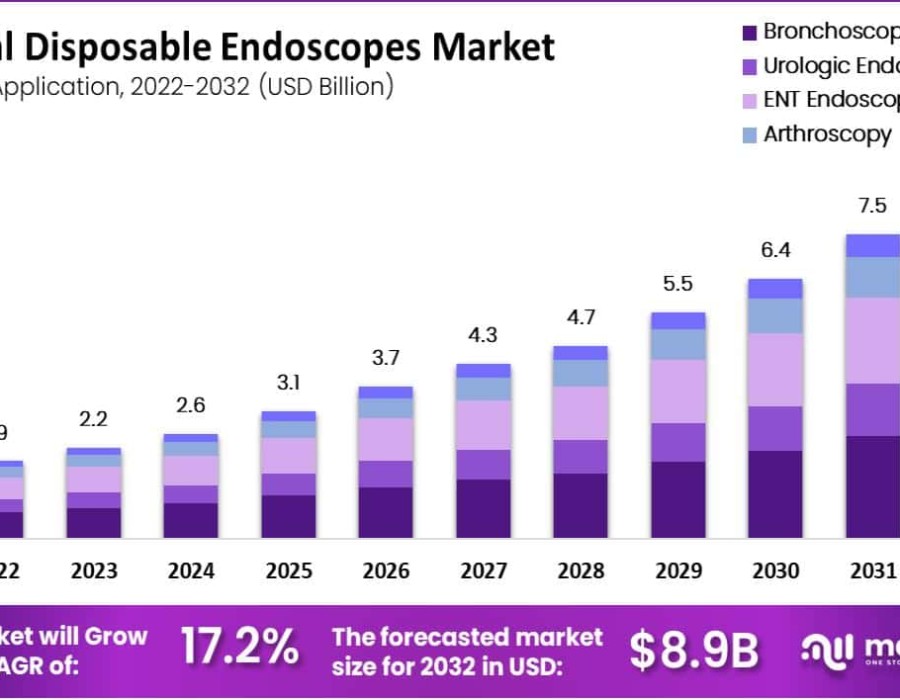Overview
12 June 2025- The Global Disposable endoscopes market valued at USD 1.9 billion in 2022, is projected to surge to USD 8.9 billion by 2032, reflecting a robust CAGR of 17.2% from 2023 to 2032. This strong market expansion is primarily fueled by the growing emphasis on infection control in healthcare settings. Unlike reusable endoscopes—which, despite rigorous cleaning, may still harbor harmful pathogens—disposable versions offer a safer alternative. Health organizations like the WHO and FDA have raised concerns over cross-contamination risks tied to reusable scopes, prompting many hospitals and clinics to transition toward single-use devices to protect patient health.
One of the major drivers behind this shift is the global rise in chronic and infectious diseases, such as gastrointestinal disorders, respiratory conditions, and certain cancers. These illnesses often require frequent endoscopic procedures, and disposable endoscopes reduce the risk of infection transmission between patients. Their single-use design makes them particularly effective in high-risk environments like emergency rooms and intensive care units, where hygiene and speed are essential.
Additionally, the growing preference for minimally invasive procedures is boosting demand. These techniques offer benefits like shorter recovery times, reduced pain, and lower hospitalization costs. Endoscopes are crucial to these surgeries, and disposable versions enhance convenience—they’re ready for immediate use, eliminate the need for sterilization, and streamline workflows in busy settings such as ambulatory surgical centers and outpatient clinics.
Reusable endoscopes, on the other hand, present operational drawbacks. They require extensive reprocessing after each use, which is both time-consuming and costly. According to the CDC, improper cleaning can lead to infection outbreaks. Adopting disposable endoscopes helps healthcare providers mitigate these risks, reduce reprocessing-related expenses, and increase overall efficiency.
Furthermore, technological improvements are making disposable endoscopes more attractive. Newer models now feature high-definition imaging and enhanced flexibility, expanding their use across various diagnostic and therapeutic procedures. Support from global regulatory authorities for single-use medical devices is also pushing the market forward, as they aim to improve safety standards and reduce hospital-acquired infections.
Together, these factors are accelerating the shift from reusable to disposable endoscopes, ensuring sustained growth and innovation in this rapidly evolving market.
Key Takeaways
- The global disposable endoscopes market is projected to reach USD 8.9 billion by 2032, reflecting strong growth potential.
- From 2023 to 2032, the market is expected to expand at a robust CAGR of 17.2%, driven by increasing demand for infection control in healthcare settings.
- In 2022, bronchoscopy procedures accounted for the largest market share, making up over 33.8% of the total disposable endoscopes segment.
- The overall market was valued at approximately USD 1.9 billion in 2022, based on recent industry insights.
- Hospitals led as the primary end-users in 2022, contributing to 48.5% of the global market share.
- North America dominated the market in 2022, capturing a 43.7% revenue share, reflecting advanced healthcare infrastructure and higher adoption rates.
Emerging Trends
Increasing Emphasis on Infection Control
Hospitals are placing greater importance on infection prevention, and reusable endoscopes pose a challenge in this area due to the difficulty of ensuring complete sterilization. Even after thorough cleaning, they may still carry bacteria, increasing the risk of cross-contamination. Disposable endoscopes, used once and discarded, significantly lower this risk. They enhance patient and staff safety, aligning with today’s healthcare priorities. As a result, single-use scopes are gaining popularity for offering greater assurance in infection-sensitive environments.
Growing Support from Health Authorities
Global health organizations are increasingly endorsing single-use medical devices. Regulatory agencies in many countries now recommend disposable endoscopes for high-risk procedures, especially where infection prevention is critical. This regulatory backing boosts confidence among healthcare providers, prompting many to shift from reusable to disposable equipment. Support from official bodies is playing a major role in accelerating market adoption and driving industry-wide change.
Advancements in Device Performance
In the past, disposable endoscopes were seen as inferior to reusable ones. However, significant improvements in image quality, handling, and overall performance have changed that perception. Many modern single-use endoscopes now rival reusable models in functionality. They’re also easier to operate, requiring less training and maintenance. These advancements are encouraging more hospitals to adopt disposable solutions, particularly for specific procedures where convenience and efficiency are critical.
Increased Adoption in Outpatient and Emergency Settings
Disposable endoscopes offer unmatched convenience in fast-paced environments such as outpatient clinics and emergency departments. Since they require no cleaning or servicing, they save time and streamline workflow. With no need for sterilization, healthcare providers can focus more on patient care and less on equipment turnaround. This efficiency is particularly beneficial in settings with limited staff or resources, driving greater adoption in these areas.
Environmental Sustainability Considerations
The widespread use of disposable medical devices has sparked concern about environmental sustainability. As the volume of medical waste grows, hospitals and manufacturers are seeking greener alternatives. Efforts are underway to develop recyclable or biodegradable endoscopes and improve waste management systems. Policymakers and healthcare leaders are also prioritizing eco-conscious purchasing decisions. Sustainability is becoming a crucial factor in the future of disposable endoscopy.
Integration of Advanced Technologies and AI
Next-generation disposable endoscopes are being enhanced with cutting-edge technology, including artificial intelligence (AI). AI-powered features can improve imaging accuracy and assist clinicians in real-time diagnostics, making procedures more precise and efficient. These intelligent tools transform endoscopes from passive viewing instruments into active diagnostic aids. While still an emerging trend, the integration of AI into single-use devices signals a promising future and adds significant value to the technology.





Comments